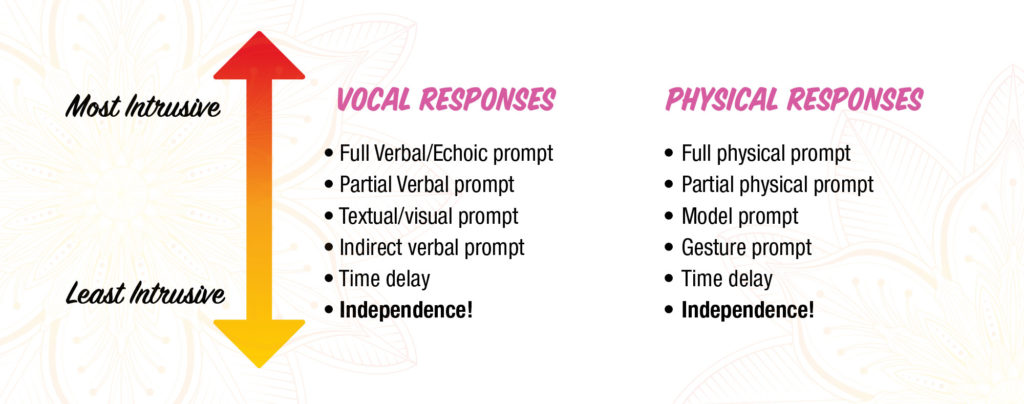Prompts are a part of everyday life. They provide clues or assistance on how to respond in a particular situation. The ding when you receive a new text message is a prompt to pick up your phone. The green light when you’re waiting at an intersection is a prompt to go. The instructions that come with a piece of furniture that needs assembling contains step-by-step prompts.
For children with autism, prompts are often needed to successfully complete skills we take for granted, like communicating wants and needs, doing self-help and personal hygiene tasks, socializing with friends, and answering questions.
The appropriate prompt to use depends on the skill being taught. For skills that require physical movement or responses, such as brushing hair, completing a puzzle, or pointing to items, physical prompts may required. Skills that require a vocal response, such as answering questions or making a request to fulfill a want or need, may require verbal or visual prompts.
Common Prompts Used in ABA Therapy
There are many types of prompts that can be used. When a verbal response is the goal, we use these types of prompts:

Most Intrusive
- Full verbal/echoic prompt – The full verbal response spoken or echoed.
- Partial verbal prompt – Part of the correct verbal response.
- Textual/visual prompt – Words or a picture of the correct verbal response.
- Indirect verbal prompt – Minimal information, like “What do you say?”
- Time delay – Additional time (5-8 seconds) is given before a prompt.
- No prompts – Independence!
Least Intrusive
When we want a physical response, these prompts are used:
Most Intrusive
- Full physical prompt – Hand-over-hand guidance for the entire physical response.
- Partial physical prompt – Physical assistance for part of the physical response. For example, when we want a child to put on a coat, we guide or direct their arm to the opening of the sleeve, then stop.
- Model prompt – Model the correct physical response for the child to imitate.
- Gesture prompt – Point or gesture. For example, we point to a pair of socks and say, “Put on your socks.”
- Time delay prompts – Additional time (5-8 seconds) is given before a prompt.
- No prompts – Independence!
Least Intrusive
Is Your Child Prompt Dependent?
When a child is unable to complete a skill they should be doing independently without prompting, the child has become prompt dependent. Prompt dependency happens when prompts haven’t been gradually eliminated or faded in an effective way. The goal when using prompts is to fade them quickly and effectively to help the child become independent.
Any skill taught for independence at The Behavior Exchange is always age-appropriate and obtainable. For example, it may be appropriate for a 3-year-old to learn how to put on their shoes, but not to tie them, since they may lack the necessary fine motor skills.
When prompting your child, use the least intrusive, most effective prompt. Ask yourself, “What is the lowest level of prompting that results in the correct response?” For example, if your child is able to consistently ask for a cookie with the partial verbal prompt of “Cuh-“, then there’s no need to use the full verbal prompt, “Say Cuh-kie.”
How to Teach a Skill AND Fade Prompts in Seven Steps
- Identify a response or skill you want your child to learn and become independent at doing.
- Use a natural opportunity or deliver an instruction for your child to respond.
- Provide the least intrusive, most effective prompt to help them learn. Refer to the lists of prompts above.
- Reinforce and reward their progress.
- Give them the instruction again with a less intrusive prompt. If it doesn’t work, move up to a more intrusive prompt and continue to attempt to quickly fade the prompts.
- Repeat #3-#5 as needed until your child can respond independently of prompts.
- Practice, practice, practice!
Some skills can be taught to reach independence almost immediately, while other skills may take days or weeks, depending on the difficulty of the skill and how many steps are involved.
Remember, practice and repetition are key to learning a skill. Ensure your child is rewarded more for responses that tend toward independence versus those that are prompted. We want them to want to be independent! We understand and appreciate that prompt fading takes practice. If our BCBAs can be of assistance, please let us know. We have two decades of ABA therapy experience, helping children become more independent and reach their full potential. We can help!
This blog post was written by Jayden Conte, BCBA

